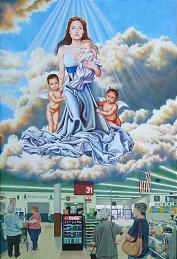Kate Kretz Painting
Kate Kretz Painting
Angelina Jolie Versus Our Lady
– Father Johann G. Roten, S.M.
Shocking for some, surprising for others the painting of Kate Kretz Blessed Art Thou shows Angelina Jolie as the Virgin Mary holding the child--we do not dare calling it Baby Jesus!--on her left arm. She is flanked by two little angels. Standing on a bank of clouds, the whole group is bathed in heavenly light. It hovers above a Wal-Mart checkout counter. The title seems strange, even blasphemous at first sight: Blessed Art Thou. But the contrast between consumerism and altruism, the check-out counter and the motherly gesture of Angelina Jolie alias Virgin Mother seems to justify the title: blessed are those who are able to transcend the greed, pleasure-seeking and the cravings of immediate satisfaction for the higher joys of giving a home and affection to the poorest of the poor, the little ones. Is this painting in praise of an actress known for her motherly instincts and recent adoptions? A contemporary version of Our Lady of the Mantle giving protection to victims of first-world consumerism, children of the Southern hemisphere?
There is nothing outright blasphemous in this painting which from an artistic point of view could hardly rival with the more prominent Renaissance portraits of Our Lady. The issue at hand is one of identity. Is this a painting of Our Lady, or is it a painting of Angelina Jolie? The immediate and most likely answer is that it has some of both. Face and posture of the feminine figure bear the distinctive traits of Angelina Jolie. Expression, motif and meaning could easily be attributed to a typical Marian representation. The overall result is one of seemingly taunting ambiguity. We are looking at a portrait of Angelina Jolie, no doubt, but is she modeling Mary, the Mother of Jesus? Or, on the contrary, are the unmistakable Marian motifs a shrewd pretext to exalt a popular actress? There is no easy answer to this question. The painting as such speaks a language of double entender. What about the artist’s intent? The little information we have seems to be pointing to Our Lady as the primary objective of Kate Kretz’s artwork. It speaks, apparently, in honor of “the most important and revered woman ever to live.”
Marian paintings were never based on picture identity or live-portraits. About Mary’s counterfeit, the color of hair and shape of nose, “non novimus” said already Augustine: we have no idea. This statement opens wide the parameter of interpretation regarding Mary’s physical appearance. It led in the first place to representations highlighting not Mary’s physique but her status. Byzantine icons of Our Lady are not interested in Mary’s bodily characteristics, but in the nobility and importance of her role as the mother of Jesus Christ, in her status as Theotokos. In order to duly evidence her God-given dignity, artists appropriated the image of the Byzantine empress, in particular, the typical posture, vestment, and courtly setting. Early Iconography suggests another, a second approach, to picture the Blessed Mother. Not only “status” was used to identify Mary but also her inner disposition, the beauty of her soul. Icons are portraits of the spiritual character of persons. The wide open eyes, the long narrow nose, and small mouth are symbols of other-directedness, of a special bond with the supernatural, of an intense sensitivity for all things spiritual. And, as is amply known, the gilded backdrop of icons emphasizes the rootedness of the holy persons in God. Here we have a second and essential character of Marian representations. Not physical appearance defines who the Mother of the Lord is, but her openness for God’s word (Orans), her intimacy with “Holy Ghost-made flesh and blood,” (Eleousa) and her constant and selfless directing the faithful away from her person – and to the fruit of her womb, Jesus Christ (Hodegetria). It is this second form of representation that becomes the chosen portrait of Mary during the middle ages: a portrait of beauty making visible the soul of Our Lady, its holiness and purity. It is only in the late middle ages, with Richard of St. Laurent and others, that Mary’s physical appearance and beauty take on a preponderant role. The color of hair and eyes, the shape of body and members are inventoried. However, physical in approach and form, the description of Mary’s person always reconnects with her spiritual profile, paralleling thereby her virtues with the physical qualities of her body.
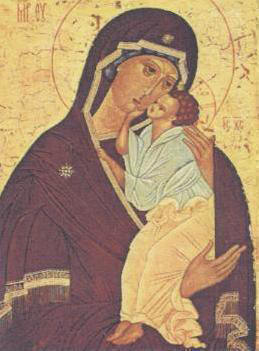
(Elousa)
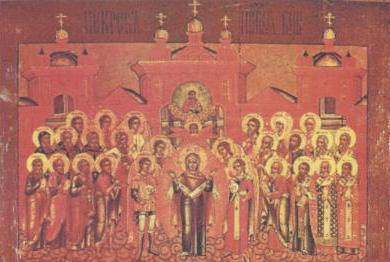
(Orans)
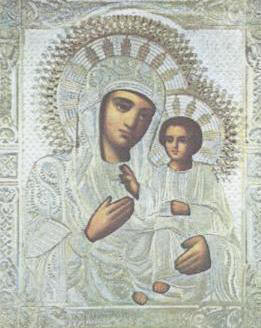
(Hodegetria)
With the beginning of the Renaissance period, a new philosophical paradigm paramount to anthropocentric exaltation, develops and leads to a this-worldly and individualized type of Madonna. Artists take their inspiration no longer from the spiritual qualities of Our Lady, but attempt to elevate concrete physical beauty to symbols of her status and personal dignity. Thus, it may happen that the Madonna will look like the artist’s sister, the “woman of his heart,” or the ideal woman of his imagination. The secularization of the Marian figure does not indicate a general trend toward the loss of religious sentiment. The very figure of Our Lady is not extracted from the traditional religious context reflecting biblical events and sacred spaces. The same applies to Baroque and Classicism. Impressionism, and especially expressionism, tend to further secularize the image of Our Lady: Madonna and Christ Child can easily be mistaken for simply mother and child; and the traditional religious framework gives way to non-descript settings.
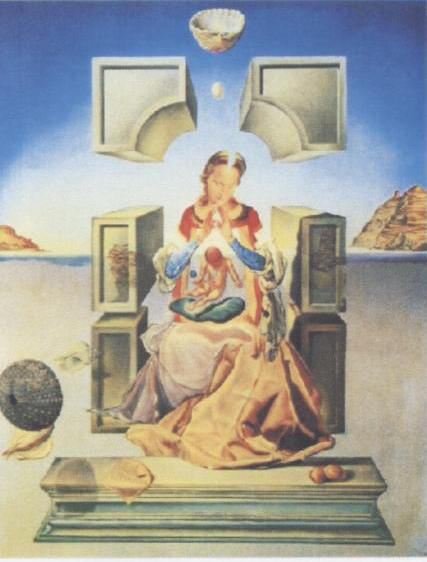
(Salvador Dali's Notre Dame)
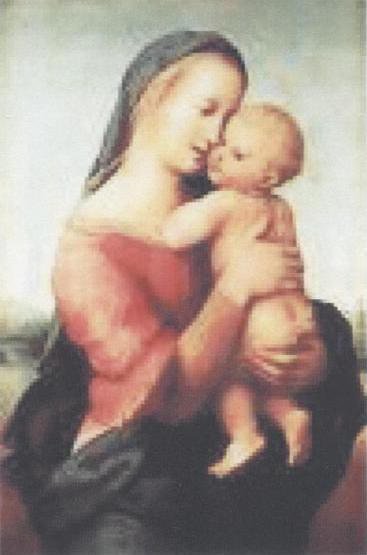
(Rafaël's Madonna Tempi)
This brings us back to Angelina Jolie and Our Lady. Is there much of a difference between the Madonna Tempi by Rafaël and Kate Kretz’s Blessed Are Thou? The former can easily be mistaken for a beautiful portrait of Mother-and-Child without religious connotation. On the other hand, who would deny Salvador Dali’s Notre Dame of Port Ligat a truly religious, albeit iconoclastic character? The Madonna figure of this 1948 painting was modeled by Dali’s wife Gala (1894-1982). In other words, Angelina Jolie is not the problem. A problem arises when there is ambiguity as to what the painting should represent. The Medium--Gala, Angelina Jolie, the model of Madonna Tempi--is to serve the message, which in the case of a Madonna representation, is essentially religious. The difficulty with Kate Kretz’s painting is not the intent of the artist but the lack of emotional and temporal distance between the onlooker and the model. For some, the model (Angelina Jolie) may be better known and more popular than the Mother of the Lord. No doubt that inasmuch as the distance in time widens, the intended reality becomes more prominent, and will probably supersede the importance of the model. However, this will only happen if the so-called religious connotation is clearly and visually expressed. In other words, a truly Marian painting needs to answer a minimum of three content-related criteria:
1. A clearly stated and expressed relation between Mary and the Divine. The figure of Mary receives her personal identity in and through this relationship which can be expressed visually in many different ways. Mary’s outstretched arms, the Christ Child’s gesture of blessing, the open skies and presence of angels, the Holy Spirit, God-Father, not least the rays descending from heaven upon her: all of these symbols will prevent the spectator of a Marian Image from perceiving Mary as an autonomous and self-contained figure, unrelated to her vocation and mission from God.
2. A second criterion refers to the humanity of Mary. Being truly and only human, a creature of God, and redeemed in anticipation of the only Savior Jesus Christ, any artistic suggestion that would make of Mary a goddess needs to be avoided. The exaltation of privileges and special graces need to be seen and understood as God-given. Thus, her beauty expresses her humanity.
3. Visual representations of Our Lady need to have some connection with salvation history, a reference and answer--some answer, at least!--for the spectator about his existence and its ultimate significance. There ought to be a “saving moment” in Marian art: for example, the Assumpta to emphasize ultimate redemption, the Hodegetria to manifest true salvation, Our Lady of the Mantle in praise of God’s mercy, or the Lady of the Magnificat to produce justice and peace.
In conclusion, representations of Mary should be a synthesis of her status (mission), her spiritual qualities (the beauty of the soul), and the beauty of physical appearance to mark her truly human and historical reality.
P.S. The following photo montage (below at left, not a painting), hangs outside the dean's office in the Information School at the University of Washington. According to one of our correspondents, it supposedly represents Bill Gates' mother replacing the Small Cowper Madonna's head (see below ) by Raphael (1505). Although intent and purpose are not immediately evident, and legitimate humor aside, we have here still another example of deconstruction and reconstruction of religious art with the result of alienating the original intent and purpose of the painting.
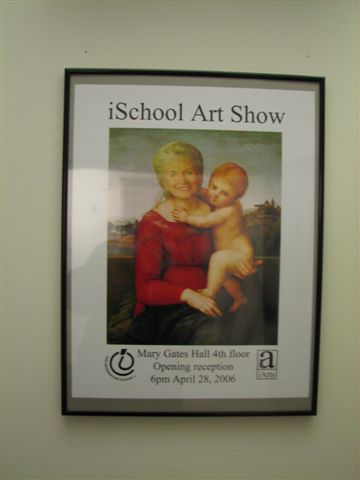
(Mary Gates, mother of Bill Gates, painted as the Madonna)
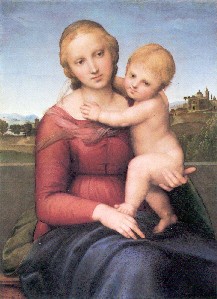
The Small Cowper Madonna (1505)
by Raphael (1483-1520)
National Gallery of Art
Washington, D.C.
All About Mary includes a variety of content, much of which reflects the expertise, interpretations and opinions of the individual authors and not necessarily of the Marian Library or the University of Dayton. Please share feedback or suggestions with marianlibrary@udayton.edu.

